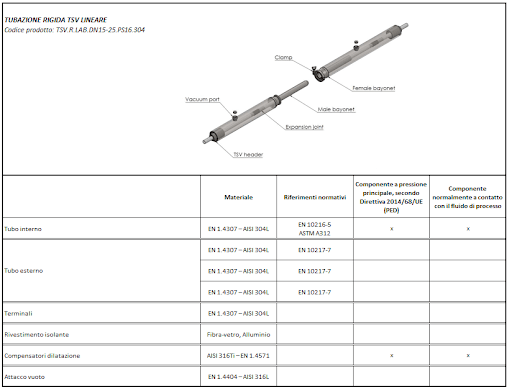
Areas of application
Food

Pharma

Metalfab

Lab & Research
MAIN FEATURES
Each modular element is composed as follows, reference the following figure:

- An inner tube, which is placed in direct contact with the pressurized cryogenic fluid and realizes its transfer, equipped with: contraction/dilatation compensators, multilayer lining of super-insulating material, and spacers made of glass fiber composite materials.
- An outer tube or shroud, which together with the outer surface of the inner tube, forms a cavity (jacket or vacuum chamber) in which a high degree of vacuum is practiced through a vacuum connection or vacuum port (homogeneity with the term used in the next point) so that the insulating material can produce maximum thermal performance. Under normal operating conditions, this section does not involve direct contact with the process fluid, except under circumstances of damage with leakage from the inner tube, in which case the associated vacuum port performs a function comparable to a rupture disk by releasing outward the pressure generated by the cryogenic fluid infiltrating the jacket
- A vacuum port through which vacuum is pumped and which ensures that the vacuum inside the TSV liner is sealed over time by means of a button fitted with an O-ring, to which high vacuum grease is applied and a metal or plastic cap, which is not sealed and has the function of retaining the button in case of release, as well as protecting the grease and O-ring from dirt and weathering
Connection between several TSV modular piping elements can be achieved by:
- Johnston-type cryogenic bayonet joints, non-permanent type (Male & Female Bayonet), secured by clamping band (Clamp)

- TSV sleeves, i.e., permanent joints generally consisting of a weld between two contiguous cold lines, covered by an outer jacket closed with two additional welds, the latter not in contact with the process fluid and not subjected to positive pressure.

The pressure system resulting from the connection of several TSV modules, which generally also includes safety and other pressure accessories, is to be understood, again according to the PED Directive**, as an assembly, i.e., an integrated and functional whole formed by a manufacturer through the assembly of various pressure equipment.
The set generally and depending on the case takes one of the following names:
- Line for the distribution ofcryogenic fluid. When characterized by a simple configuration, that is, one input terminal (supply point), one output terminal (delivery point) and any accessories (valves, safety valves, etc.)
- Piping system for the distribution of cryogenic fluids. When characterized by an articulated configuration, that is, one or more input terminals, one or more output terminals, and any accessories (valves, safety valves, etc.)
(**) It should be noted that even in cases where the product is not classifiable in the Categories referred to in the PED Directive, the application of Art. 4.3 of the Directive still applies, which requires the Manufacturer to comply with the following specific requirements:
BENEFITS
- Significant savings, both in terms of process and cryogenic product, due to higher operational efficiency and lower consumption compared to alternative technological solutions (traditional insulation; dynamic vacuum; etc.)
- Long service life, TSV pipes predict a rated life of 5000 cycles*
- Low assembly costs (in the case of Johnston-type bayonet joint solutions)
- Low operating costs due to TSV technology that provides a slow decay of vacuum grade with long maintenance intervals (generally every 5 years)
- Design reliability and robustness of materials
- Certified quality for the entire supply cycle, from design to product release, either ex-works or at the customer’s site, as appropriate.
(*) 1 cycle = 1 full thermal cycle, i.e., cooling from room temperature to cryogenic fluid temperature and back to room temperature.
TECHNICAL DATA.
The TSV modular piping family is divided into two product series:
| Serie | PS | Caratteristiche distintive |
|---|---|---|
| TSV IND | 16 bar g | Dimensioni e DN disponibili riportati nella seguente Tabella IND. Tubazioni realizzate con tubi elettrouniti EN 10217-7 e raccorderia a saldare EN 10253-4 Materiali secondo seguente Tabella |
| TSV LAB | 16 bar g | Dimensioni e DN disponibili riportati nella seguente Tabella LAB Tubazioni realizzate con camicia esterna in tubo elettrounito EN 10217-7 e raccorderia a saldare EN 10253-4, e linea fredda in tubo schedulato, senza saldatura, ASTM A312 / EN 10216-5 e raccorderia in schedula senza saldature ASTM A403. Materiali secondo seguente Tabella |
For both series, TSV IND and LAB, the following construction and quality parameters are met:
| Max length for rigid linear piping spools | 6m |
|---|---|
| Grade of vacuum | 10-5 mbar. The absence of condensation on TSV modules is only guaranteed under the following ambient conditions Relative Humidity ≤ 70%; 15°C ≤ Ambient T. ≤ 25°C |
| Quality control | Overall testing of equipment, wetted parts and vacuum chamber, using technology-based leak detection system with Helium as tracer gas. Acceptability threshold ≤ 10-8 mbar * l/s. |










